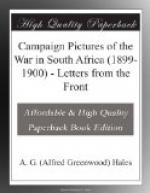During the night that followed it was considered expedient that the Highland Brigade, about 4,000 strong, under General Wauchope, should get close enough to the lines of the foe to make it possible to charge the heights. At midnight the gallant, but ill-fated, general moved cautiously through the darkness towards the kopje where the Boers were most strongly entrenched. They were led by a guide, who was supposed to know every inch of the country, out into the darkness of an African night. The brigade marched in line of quarter-column, each man stepping cautiously and slowly, for they knew that any sound meant death. Every order was given in a hoarse whisper, and in whispers it was passed along the ranks from man to man; nothing was heard as they moved towards the gloomy, steel-fronted heights but the brushing of their feet in the veldt grass and the deep-drawn breaths of the marching men.
So, onward, until three of the clock on the morning of Monday. Then out of the darkness a rifle rang, sharp and clear, a herald of disaster—a soldier had tripped in the dark over the hidden wires laid down by the enemy. In a second, in the twinkling of an eye, the searchlights of the Boers fell broad and clear as the noonday sun on the ranks of the doomed Highlanders, though it left the enemy concealed in the shadows of the frowning mass of hills behind them. For one brief moment the Scots seemed paralysed by the suddenness of their discovery, for they knew that they were huddled together like sheep within fifty yards of the trenches of the foe. Then, clear above the confusion, rolled the voice of the general—“Steady, men, steady!”—and, like an echo to the veterans, out came the crash of nearly a thousand rifles not fifty paces from them. The Highlanders reeled before the shock like trees before the tempest. Their best, their bravest, fell in that wild hail of lead. General Wauchope was down, riddled with bullets; yet, gasping, dying, bleeding from every vein, the Highland chieftain raised himself on his hands and knees, and cheered his men forward. Men and officers fell in heaps together.
The Black Watch charged, and the Gordons and the Seaforths, with a yell that stirred the British camp below, rushed onward—onward to death or disaster. The accursed wires caught them round the legs until they floundered, like trapped wolves, and all the time the rifles of the foe sang the song of death in their ears. Then they fell back, broken and beaten, leaving nearly 1,300 dead and wounded just where the broad breast of the grassy veldt melts into the embrace of the rugged African hills, and an hour later the dawning came of the dreariest day that Scotland has known for a generation-past. Of her officers, the flower of her chivalry, the pride of her breeding, but few remained to tell the tale—a sad tale truly, but one untainted with dishonour or smirched with disgrace, for up those heights under similar circumstances even a brigade of devils could scarce have hoped to pass. All that mortal men could do the Scots did; they tried, they failed, they fell. And there is nothing left us now but to mourn for them, and avenge them; and I am no prophet if the day is distant when the Highland bayonet will write the name of Wauchope large and deep in the best blood of the Boers.




